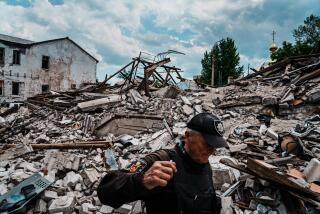Bosnia Enclave of Bihac Faces 3-Way Siege
- Share via
SARAJEVO, Bosnia-Herzegovina — While a new contingent of U.N. combat troops dug in near this besieged capital Monday, three rebel armies pressed a massive offensive on the government-held enclave of Bihac, gaining ground, endangering the U.N.-designated “safe area” and sending thousands of Muslim refugees fleeing.
The Zepa, a third “safe area,” the Bosnian government and Bosnian Serb forces agreed on a plan for the evacuation of thousands of women and children. A U.N. spokeswoman in Sarajevo said early today that the government forces had agreed to put their weapons under U.N. control, clearing the way for the ultimate surrender of the enclave. Zepa would be the second safe area to be overtaken in two weeks.
The Bihac pocket in northwestern Bosnia-Herzegovina, home to 150,000 people, has come under heavy tank and mortar fire since Wednesday in what U.N. officials described as the most serious fighting in Bosnia in months.
The fighting involves Croatian Serbs who have crossed into Bosnia from Croatia; Bosnian Serbs, and a renegade Muslim militia. Thousands of rebel troops, backed by 100 tanks, are attacking the Bosnian government’s army there, a senior government official said.
The Bosnian war could easily widen and escalate if Croatia, which has pledged to support Bosnia against a common Serbian enemy, enters the battle.
“This is an extremely escalatory step,” U.N. spokesman Alexander Ivanko said of the attacks on Bihac. “We have an attack across an international border, we have basically three warring factions taking part in this attack . . . [and] might see more factions drawn in.”
As Bihac exploded, about 300 British troops from the new U.N. rapid-reaction force arrived atop Mt. Igman, just west of Sarajevo, and dug emplacements for two light-artillery batteries meant to respond to Bosnian Serb attacks on peacekeepers. The first of a 500-member unit of the French Foreign Legion also arrived.
The winding, unpaved road over Mt. Igman is the only route into Sarajevo that is not controlled by the rebel Serbs--who, nevertheless, target it frequently with mortar fire.
The new Anglo-French contingent is armed with 12 105-millimeter light guns with a range of 10 1/2 miles, equipment that will substantially enhance the peacekeepers’ firepower.
U.N. officials repeated Monday that the units of the European rapid-reaction force ordered into action are assigned to protect U.N. personnel and installations, not the civilians of Sarajevo.
That major battles raged in one corner of Bosnia while the United Nations tried to shore up its defenses in another underscored the basic weaknesses in the international community’s haphazard attempts to contain the war in Bosnia, analysts noted.
Even as the West threatens “unprecedented” air strikes and deposits substantial firepower on the ground, the Serbs have pushed deeper into the Bihac pocket and continue to shell other U.N.-designated safe areas.
After a London meeting last week, Western allied leaders trying to display more resolve warned the Bosnian Serbs against further attacks. But confusion persists over what exactly would trigger a more robust international response.
The meeting singled out the safe area of Gorazde as the key site, and U.S. officials have re-emphasized this view. But that left the status of other safe areas in doubt. Gorazde has been relatively free of attacks for days.
The safe areas began to fall July 11 when the Bosnian Serbs captured Srebrenica and, in the practice of “ethnic cleansing,” ejected more than 30,000 Muslim refugees, many of whom later reported widespread rapes and murders by the nationalist Serbs.
In the first official assessment by U.N. human rights officials of the treatment of the Muslims, special envoy Tadeusz Mazowiecki, the former prime minister of Poland, said Monday that the Bosnian Serbs committed “barbarous acts” and violated human rights “on an enormous scale.”
Similar scenes are feared if the other enclaves are overrun.
In Bihac, Croatian Serbs pushed at least 2 1/2 miles into the enclave and were thought to have seized about 30 square miles of territory along the western border of the pocket, U.N. officials said.
Bihac is of enormous strategic value to the Serbs. By capturing the enclave, they gain important rail lines and roads that link Bosnian Serb territory to the east with Croatian Serbs to the west.
On Saturday, Croatian President Franjo Tudjman formally promised Bosnian President Alija Izetbegovic that he would send troops to protect Bihac, which is defended by the government army’s vaunted but outgunned Fifth Corps. There is much speculation now over whether Tudjman will actually provide the aid; in the past, his government has blocked the delivery of weapons to the Bosnians.
Tudjman may decide to use the anarchy in Bihac as justification for attacking the Croatian Serbs who control just under a third of Croatia. He has vowed for some time to take back the land that the Croatian Serbs have occupied since their 1991 war of secession.
Battles in the Bihac pocket have already forced almost 3,000 people from their homes, most fleeing toward the town of Bihac. U.N. officials said they fear that the rebel forces will push from all sides to squeeze the enclave into a smaller and smaller patch of territory.
The offensive will “trigger a huge wave of refugees,” U.N. aid official Kris Janowski said. “The problem is, these people have nowhere to go.”
Meanwhile, in Paris, the French government denied a report by the newspaper Liberation that a French jet on Sunday had attacked the residence in Pale, the self-ascribed Bosnian Serb capital, of a close associate of rebel leader Radovan Karadzic.
* U.S.-U.N. RIFT: Disagreement develops over right to order air strikes. A8
More to Read
Sign up for Essential California
The most important California stories and recommendations in your inbox every morning.
You may occasionally receive promotional content from the Los Angeles Times.














